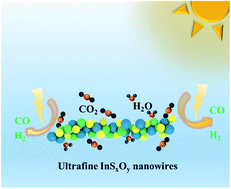Synergistic effects in ultrafine amorphous InSxOy nanowires boost photocatalytic syngas production from CO2†
Abstract
Visible-light-driven synthesis of syngas has been widely regarded as an ingenious strategy to realize the comprehensive utilization of CO2. Herein, a cooperative strategy based on S-atom substitution and morphology regulation was adopted to design ultrafine amorphous InSxOy nanowires (NWs) for boosting the photocatalytic production of the CO/H2 mixture. Surprisingly, the crystallinity and morphology of the products could be tuned easily by varying the amount of thiourea, which in turn influenced their photocatalytic activity. The as-prepared InSxOy NWs demonstrated remarkable production rates of 336 and 812 μmol g−1 h−1 for CO and H2, respectively, one of the most competitive performances for In-based materials. In situ Fourier transform infrared spectra confirmed that InSxOy NWs with strong CO2 capturing ability were conducive to the formation of the COOH* intermediate, accelerating the photoreduction efficiency significantly. Enhanced photocatalytic activity was ascribed to the synergistic effects of the distinctive ultrafine structure and S-atom substitution, which not only decreased the band gap of indium oxide but also promoted the charge–hole separation/transportation on the catalyst surface. This work emphasized a facile technique regarding heteroatom substitution and morphology regulation, inspiring an alternative pathway for fabricating photocatalysts with high-activity toward solar-driven syngas production.



 Please wait while we load your content...
Please wait while we load your content...